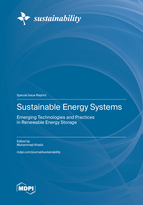Sustainable Energy Systems: Emerging Technologies and Practices in Renewable Energy Storage
A special issue of Sustainability (ISSN 2071-1050). This special issue belongs to the section "Energy Sustainability".
Deadline for manuscript submissions: closed (31 December 2022) | Viewed by 42405
Special Issue Editor
2. Center for Renewable Energy and Power Systems, KFUPM, Dhahran 31261, Saudi Arabia
3. SDAIA-KFUPM Joint Research Center for Artificial Intelligence, KFUPM, Dhahran 31261, Saudi Arabia
Interests: advanced control; distributed generation; energy storage systems; forecasting; micro grids; optimization techniques; renewable power systems; hydrogen systems; smart grids; artificial intelligence; machine learning
Special Issues, Collections and Topics in MDPI journals
Special Issue Information
Dear Colleagues,
The global transition towards renewable integration in the energy sector comes with unique challenges and opportunities. At present, many renewable technologies impose a power quality and stability threat that concurrently limits their commercialized deployment. The current developmental trend strives to establish renewable integration based on the concept of microgrid-using technologies such as forecasting, power electronics and energy management to ultimately formulate a deregulated and sustainable smart grid. The recent advancement in renewable technologies in combination with the growing need for optimal energy storage utilization consists of many research and knowledge gaps that require meticulous research initiatives and innovation.
In similar terms, the concept of an energy storage system as an energy buffer—that is, to store/supply abundant/deficit power—has proven to be a pivotal methodology for suitable growth in renewable integration. However, appropriate advancements are urgently required in the areas of constructional, conceptual, and power management to obviate contraptions focused on individual energy storage technologies. Accordingly, with the commercialization of electric vehicles, the concept of utilizing vehicular storage devices to enhance the techno-economic significance of multi-energy renewable systems encourages its potentiality for future sustainable power systems.
This Special Issue provides a unique platform to present state-of-the-art research findings in all fields of renewable energy integration and innovative solutions associated with the development and selection of renewable and energy storage technologies to overcome distinctive technical challenges related to sustainable power establishment. This Special Issue aims to facilitate and promote interdisciplinary researchers to provide multi-faced solutions related to renewable energy and energy storage systems.
Dr. Muhammad Khalid
Guest Editor
Manuscript Submission Information
Manuscripts should be submitted online at www.mdpi.com by registering and logging in to this website. Once you are registered, click here to go to the submission form. Manuscripts can be submitted until the deadline. All submissions that pass pre-check are peer-reviewed. Accepted papers will be published continuously in the journal (as soon as accepted) and will be listed together on the special issue website. Research articles, review articles as well as short communications are invited. For planned papers, a title and short abstract (about 100 words) can be sent to the Editorial Office for announcement on this website.
Submitted manuscripts should not have been published previously, nor be under consideration for publication elsewhere (except conference proceedings papers). All manuscripts are thoroughly refereed through a single-blind peer-review process. A guide for authors and other relevant information for submission of manuscripts is available on the Instructions for Authors page. Sustainability is an international peer-reviewed open access semimonthly journal published by MDPI.
Please visit the Instructions for Authors page before submitting a manuscript. The Article Processing Charge (APC) for publication in this open access journal is 2400 CHF (Swiss Francs). Submitted papers should be well formatted and use good English. Authors may use MDPI's English editing service prior to publication or during author revisions.
Keywords
- Need for renewable energy, challenges, and opportunities
- Impact of renewable technology on environment and climate change
- Renewable energy policy
- Emerging renewable and storage technologies
- Global practices of commercial and residential renewable integration
- Renewable energy economics (hydrogen economy, carbon accounting, carbon emission, regionalization and legislation of renewable installation)
- Renewable process control (solar, wind, biomass, hydro, tidal geothermal, desalination, solar thermal, solar chimney, electrification of natural gas)
- Electric vehicle (EV) technologies in renewable power system (peak shaving, load following, swappable storage stations)
- Renewable power electronic converters: topology, structure, and optimization
- Advancement and development in energy storage technologies that include, but are not limited to: electrochemical storage (e.g., lithium-ion, lead-acid, nickel-cadmium, sodium-sulfur), thermoelectric storages, electromechanical/mechanical storage, electromagnetic storage systems, thermal storage, chemical storage, flow batteries, supercapacitors, hybrid energy storage systems, hydrogen storage and mobility
- Development and advancement in renewable and storage materials (organic materials, organic electrodes, nanomaterial, nanohybridization, functional nanomaterials, flexible batteries, electrochemical analysis, degradation)
- Innovations in smart grids and microgrids
- Renewable flexibility, reliability, and resilience
- Self-healing renewable grids
- Optimization, control and forecasting of renewable energy sources
- Renewable and distributed system planning and operation
- Output power smoothing of renewables and optimal power dispatch
- Energy storage efficacy in renewable deployment
- Load forecasting
- Demand response and demand side management
- Machine learning applications in renewable storage systems
- Energy storage applicability in power quality, grid stability, and renewable flexibility






